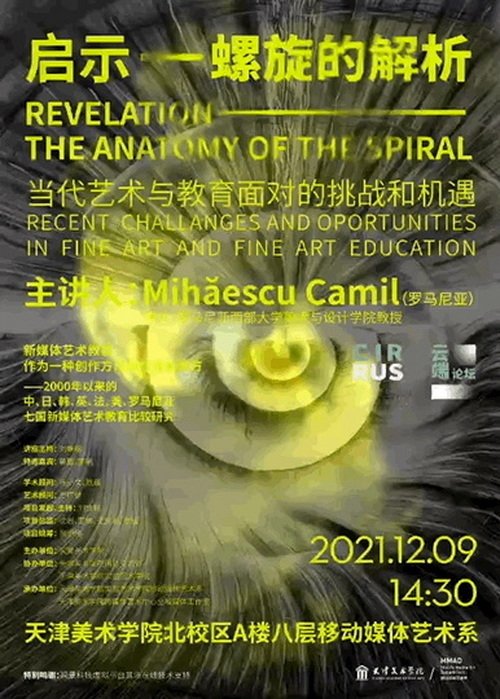
“天津美术学院实验艺术学院云端论坛计划” 之(子项目)
新媒体艺术教育作为一种创作方法从东方到西方
New Media Art Education as A Creative Method from East to West
——2000年以来的中、日、韩、英、法、美、罗马尼亚七国新媒体艺术教育系列讲座
—— A comparative study on new media art education among China, Japan, South Korea, Britain, France, the United States and Romania since 2000
项目周期 (Project Cycle):2021.9-2022.6
主办单位︱Sponsor
天津美术学院
Tianjin Academy of Fine Arts (TAFA)
指导单位︱Consultant
天津美术学院国际交流处
International Affairs Office, TAFA
承办单位︱Organizers
天津美术学院实验艺术学院移动媒体艺术系
Mobile Media Art Department, School of Experimental Art
天津美术学院跨媒体艺术中心全域媒体工作室
Global Media Studio of Transmedia Arts Center, TAFA
学术顾问︱Academic Advisors
陈小文 Chen Xiaowen
甄巍 Zhen Wei
艺术总监︱Art Director
贾广健 Jia Guangjian
项目总监︱Project Director
沈岩 Shen Yan
王爱君 Wang Aijun
范敏 Fan Min
张锰 Zhang Meng
发起、主持︱Project Initiator and Host
刘姝铭 Liu Shuming
项目统筹︱Overall Planning
张书恒 Zhang Shuheng
项目发起理念
自本世纪2000年以来,科技和媒介的迭代日新月异,世界各国媒体艺术领域的发展呈现出非常活跃的态势,新媒体艺术教育亦在其中扮演重要角色。新媒体艺术相较于其他艺术门类,源于它与科技演进的密切关系,它似乎具有跨越种族、国界和文化的天然基因,也具有更加广泛的国际交流和对话的可能性,它甚至可以成为建构不同文化和社会关系的纽带。然而,某种程度上,在媒体艺术近二十年的发展过程中,也不断暴露出自身的各种局限,诸如语法学层面的概念性规范、与技术的关系等问题;以及如何剥离技术的表象,跳脱资本的逐利式裹挟,真正进入新媒体艺术创作的内核,是各国媒体艺术教育者、学生、创作者共同面临的问题。
诸多值得讨论的问题几乎涵盖了新媒体艺术从宏观到微观的整个跨度。宏观方面,在西方艺术史脉络中,新媒体艺术的前世今生,以及它的生发机制和内在创作逻辑到底是什么?是否可以把激浪派(flux)作为它的发端;那么,以白南准(Nam June Baik)和约翰 凯奇(John Cage)为代表的艺术家们的创作理念和实践与东方神秘主义的关联是什么,激浪派又如何受到马尔库塞等哲学家们思想的影响,奠定了新媒体艺术的先天思辨性与不断反思和革新的基因;以及以麦克卢汉(Marshall McLuhan)为代表的泛媒介论又如何影响着新媒体艺术与应用设计的结合。
在微观层面,无论在教育领域的专业命名,还是产业界应用,以及学界的规范表述上,关于媒体艺术名称的多种混淆,比如新媒体艺术、数码媒体艺术、多媒体艺术、跨媒体艺术、数字媒体艺术等,我们无意去统一,但有必要分别从东西方的艺术发展脉络中展开回溯与对话,从学者、教育实践者的角度为媒体艺术的来龙去脉建立事实陈述,以作品佐证的工作方法建立各自艺术史的上下文关系和互文自洽,并展开相应的脉络梳理和发展现状的比较研究。
另外,新媒体艺术教育相较于其他艺术门类,它在东西方各国的发展起点相近,发展路径相似,各国的发展现状如何,以及各自的特色和优势等,尤其面对即将到来的人工智能时代,媒体艺术教育共同面对的系列问题皆值得交流探讨。基于此,我认为是时候以亲历者,参与者的身份在东西方之间重新建立连接,为中、日、韩、英、法、美为代表的东西方媒体艺术教育现状的比较研究搭建平台,同时包括一带一路国家代表东欧罗马尼亚蒂米什瓦拉西部大学艺术学院。希望这种对谈、交流,扮演一个采样者的角色,站在人类命运共同体的角度,共同开启后疫情时代,媒体艺术教育国际交流的新探索。同时,为媒体艺术教育的未来愿景提供一种文献参考。
刘姝铭 2021.7
Project Initiation Concept
Since 2000, as technologies and media iterate develop rapidly, media art around the world has also taken on a robust trend, in which new media art education plays an important role. Compared with other kinds of art, new media art, due to its close relationship with technological evolution, seems to possess the natural gene to transcends races, nations and cultures and the possibility of more extensive international exchanges and dialogues. It can even become a bond to construct different cultural and social relations. However, to some extent, media art has also exposed various limitations in its development over the last two decades or so, such as the conceptual norms at the level of syntactics, its relationship with technology and so forth. And what puzzles me as well as media art educators, students and creators all over the world is how to break away from media art’s technological appearance, get rid of the profit-seeking coercing of capital, and genuinely get to the core of new media art creation.
Issues worth discussing almost cover the whole span of new media art from macro to micro levels. From a macro perspective, in the context of western art history, what is the origin of new media art, how to define its generative mechanism and internal creation logic? Can we say flux is the beginning of it? Then, what is the connection between creative ideas and practices of artists represented by Nam June Baik and John Cage and eastern mysticism? And how was the Flux influenced by Marcuse and other philosophers and produced the innate speculation, constant reflection and innovation genes of new media art? And how does the pan-media theory represented by Marshall McLuhan influence the combination of new media art and application design?
At the micro level, media art is given confusing names, whether it is a professional naming in the filed of education, or how it is called in the industrial application, or the normative expression in academia. There are many kinds of confusing names, such as new media art, digital media art, multimedia art, cross-media art, digiting media and so forth, which we have no intention to unify. But it is necessary to trace back the development process of eastern and western art, make dialogues and statements of facts from the perspectives of scholars and education practitioners, use art works as evidences to establish context diagram and intertextuality self-consistency of the art history, and make comparative study of the development history and status quo.
In addition, compared with other arts, new media art education has similar starting point, development path in eastern and western countries. There are many issues worth discussing, such as the current development, specific characteristics and advantages in each country, and a series of issue commonly faced by media art education in the coming era of artificial intelligence. In light of these issues, I believe it is time for me as a witness and a participant to re-establish a connection between the east and the west, build a platform for comparative study of eastern and western media art education in representing countries such as China, Japan, South Korea, Britain, France, the United States, as well as countries along the belt and road route, including College of Art and Design of West ,University of Timisoara that represents Romania in Eastern Europe. It is hoped that such dialogue and exchange can play the role of a sampler to jointly explore international communications of media art education in the post-epidemic era. With a more open mind, it provides a literature reference for the future media art education from the perspective of building a community of shared future for mankind.
Liu Shuming 2021.7
项目首场讲座
The First Lecture

讲座主题:面部艺术
讲座时间:2021年9月28日14:00
主讲人:金亨基(韩国中央大学校尖端映像科技系教授,韩国媒体艺术教育先驱)
讲座主持:刘姝铭(天津美术学院移动媒体艺术系主任,副教授)
特邀对谈嘉宾:孙峰(天津美术学院移动媒体艺术系讲师)、赵宏伟(天津美术学院移动媒体艺术系副教授)



.jpg)


点击进入
金教授作为韩国最具代表性的媒体艺术教育参与者和亲历者,透过他个人自上世纪八十年代以来,几十年的创作脉络,我们清晰可见:观念与思想才是媒体艺术及媒体艺术教育领域恒常的内驱力,技术和媒介的迭代与墒化,始终作为艺术家艺术表达的载体而存在。
项目第二场讲座
The Second Lecture

讲座主题:影像艺术的触觉与气氛
讲座时间:2021年10月26日08:30
主讲人:陈小文(美国阿尔弗莱德大学、中央美术学院教授、博导)
讲座主持:刘姝铭(天津美术学院移动媒体艺术系主任,副教授)
特邀对谈嘉宾:甄巍(教授、博导,北京师范大学艺术与传媒学院副院长)、马良(天津美术学院移动媒体艺术系讲师)








点击进入
一缕斜阳、一抹粉红,定格跨越时空的相聚。近二十年来,在中美媒体艺术教育之间穿针引线的陈小文教授,无疑是中国数码媒体艺术教育的先驱和重要实践者,他借由影像艺术的质感、触觉等抽象感知系统为我们梳理了媒体艺术的基因与底色。在对谈环节,甄巍教授也从造型艺术和东西方艺术比较的视角,再次强调了摒弃习得和理性认知,回归当下时空的感性即兴的珍贵。在大数据算法、计算机生成大行其道的新一轮数字殖民时代,这种不可被程序化的本能体验,也许可以被当作一种缓冲通道。
项目第三场讲座
The Third Lecture

讲座主题:新媒体艺术,新媒体文化
讲座时间:2021年11月12日08:30
主讲人:Peer Bode(美国阿尔弗莱德大学教授、被誉为媒体艺术活字典)
讲座主持:刘姝铭(天津美术学院移动媒体艺术系主任,副教授)
特邀对谈嘉宾:刘晓霞(任教于太原理工大学外语学院、翻译、国际策展人;平遥国际摄影大展国际部主任)、王国俊(天津美术学院移动媒体艺术系讲师)









点击进入
有美国媒体艺术史的活字典之称的Peer教授,在讲座中为我们梳理的媒体艺术流派、艺术家、作品,以及媒体艺术跟其他学科的互文关系,几乎可以填满中美之间的太平洋。
项目第四场讲座
The Fourth Lecture

讲座主题:启示——螺旋的解析
讲座时间:2021年12月9日14:30
主讲人:Mihăescu Camil(博士、罗马尼亚西部大学美术与设计学院院长、教授)
讲座主持:刘姝铭(天津美术学院移动媒体艺术系主任,副教授)
特邀对谈嘉宾:李岩(北京师范大学艺术与传媒学院副教授)、蒋旎(天津美术学院移动媒体艺术系副主任,副教授)







点击进入
透过卡米尔教授的分享让我们对新媒体艺术在东南欧国家的现状得以了解。卡米尔教授以“螺旋”这一母题,贯穿其创作主线,在摄影、绘画、综合媒介等材料、造型语言的探索中,蕴含着丰富的对艺术本体价值的解析。作为罗马尼亚最重要的艺术院校的领军者,他在传统媒介与新媒介的穿梭中为我们折射出:传统媒体和新媒体之间存在巨大的融通空间。
——项目未完待续,敬请期待——

【声明】以上内容只代表原作者个人观点,不代表artda.cn艺术档案网的立场和价值判断。

